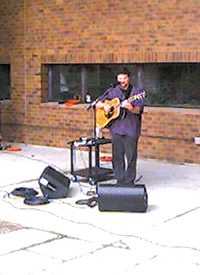Points of Departure
January 26, 2002
I like art. Reviewing it is sort of neat too. However, as the Harbor Art Gallery’s latest exhibit “Points of Departure” went up, I was stuck standing there wondering “What the hell…?” It looked as if Legoland knockoffs, graffiti, and giant-sized bugs had taken over. It’s a psychedelic replication the bad trip you never hope to go on.
This time, the three artists displaying their work are Augustine Romero, Rory MacArthur, and William Niemeier. Their statement reads: “Mass culture has always played a major role in the transformation of art. In this case, material is one important factor…Each artist uses pop culture differently and this is where the work gels together because an unlikely community is united. Since traditional art materials are not used, the traditional bonds to painting and sculpture are neglected and what we are left with are objects which seem to have been removed from another context, thereby questioning the standard academic definitions of art.”
I suppose that’s another way of saying I’m confused because it doesn’t relate to any of the art I was exposed to. Normally, abstract art annoys me. I spend five minutes looking at a piece and another thirty seconds hunting for a name so I can get some idea of what it was intended to be.
With Rory MacArthur (of the aforementioned “bugs”), I had to modify my approach and open my mind. Slowly but surely, the painful process begins. The name of his exhibit is “A Space Odyssey” named for the ’60s movie 2001: A Space Odyssey where a psychotic computer named Hal goes nuts and murders the crew of its space ship. I’m not sure what the relevance is, maybe pop culture roots, but the name is appropriate enough.
There are plenty of strange, sinister looking, fluorescent constructs named according to number and material (mixed media). With cylindrical pipes and geometrically harmonic bodies, they resemble insects of Costco-esque proportions.
Augustine Romero has taken a different path, naming his works for Latin American mythological figures and landscapes. I was further confounded by what appeared to be plexi-glass and wood “limbs” sticking out at odd angles, peppering the wall, reminiscent of arms and legs stolen from plastic puppets.Yet, I enjoyed the “Yellow-Urban Land Scape,” a large piece of plywood shot through with purple and yellow interspersed with car parts.
William Neimeier’s exhibit occupies the back room. It looks like a scene out of Star Wars placed underwater with machines vs. man sort of theme. The name of it is “Toys in Technoland,” a display I probably enjoyed most of all. It’s made up of a number of different individual displays incorporating urethane, rubber, foam, with a blinding Dayglo gloss. There’s a sense of fun to this, making me remember the days of being a kid in a world of Legos and wooden blocks.
I think I’ve learned something from writing this. I’m not sure what but it can be summed up as a greater appreciation for the many strange and unique styles the world has to offer.





















































